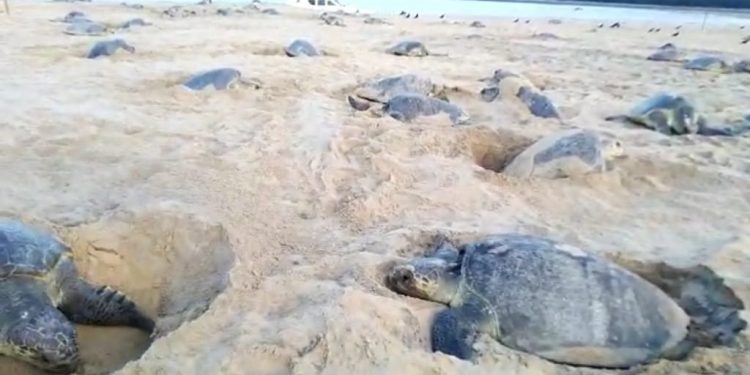Kendrapara: The decline in the number of Olive Ridley turtles for mass nesting at Gahirmatha Marine Sanctuary near Bhitarkanika National Park in this district for the last two years has sparked concern among the environmentalists, sources said Sunday. According to an official report, 5.11 lakh Olive Ridley turtles had laid eggs at Gahirmatha in 2022. The number decreased slightly, to around five lakh in 2023. However, this year the drop in the number of turtles visiting the sanctuary is alarming.
According to official estimates, only three lakh turtles have arrived at Gahirmatha. This massive decline in numbers has sparked fears of drastic climate changes or some massive natural disaster in the offing. Hemant Kumar Rout, secretary of ‘Gahirmatha Marine Turtles and Mangrove Protection Committee’, environmentalists Khitish Kumar Singh and Srikant Nayak said there are several reasons behind the decrease in numbers. They pointed out that erosion and loss of land mass is one of the main reasons behind the decrease in several turtles visiting the sanctuary. As the land is being gobbled up by the sea, the nesting places of the turtles are also being reduced.
Hence many turtles are staying away from the sanctuary, pointed out Nayak. Rout on the other hand, added that the only way to stop the erosion is through a plantation of mangroves. “However, awareness programmes about the importance of mangroves and the plantation drive have not been properly implemented,” he pointed out. The three informed that the mushrooming prawn gheries in Bhitarkanika National Park have a role to play in soil erosion. They said that the chemical laced water released from these gheries acts as a ‘killer’ for whatever little mangrove plantation is there. The toxic water also affects the turtles and hence it may be another reason why a lesser number of turtles are visible in Gahirmatha this year. Fishermen and changes in climate are the other main reasons why there is a decrease in the number of turtles. Despite bans, fishermen enter prohibited areas inside the sea.
In the process, many turtles die after getting entangled in the nets, the three opined. They also pointed out that earlier the turtles used to lay eggs in March, but this year they have done so in April. This time shift is proof enough that some climatic change is affecting the visiting turtles, the environmentalists pointed out. They warned that the turtles will stop visiting Gahirmatha for mass nesting like Harachandi coastline in Puri district if the natural environment is not restored at the earliest. When contacted, Gahirmatha ranger Pradosh Moharana said the Forest department is taking a number of measures for the protection of the turtles. He pointed out that mangrove forest plantations are being carried out to solve the erosion issues.
Security has also been beefed up to prevent the unauthorised entry of fishermen in prohibited zones. “We will shortly conduct a review to find out why the number of turtles visiting Gahirmatha this year has declined. Accordingly, we will take steps,” said Moharana.






































